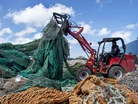BMW circular EV materials reduce manufacturing impact

Circular economy is a growing trend across multiple industries, but the ability to incorporate such a global strategy requires strategic partnership and the relevant expertise to extract materials, like plastics from already polluted waters.
The latest initiative from the automotive giant, BMW, is to take plastic from the ocean and use it in the electric vehicle (EV) manufacturing process. The company really wasn’t messing around when it proposed circular economy as a next step for its vehicle line up.
EVs reduce sea trash from maritime industry
Its display of circular principles is very much aligned with the need to change. While decarbonisation is one of the primary reasons for electrification of the motoring industry, the key organisations are also pressed to reduce the impact of their vehicles from a waste perspective, or to reduce their environmental impact by design. Not only do car companies need to source less contaminant products, but they have the power to reuse plastics, much like what BMW is doing.
Its exclusive process will extract waste materials from the maritime industry, such as fishing nets, ropes and other sea trash, and use them in their next-generation EVs. This will result in a reduction of each vehicle’s carbon footprint as BMW designs 30% recycled materials into the—either in the interior of its cars or external components.
The process will be implemented in partnership with a Danish company called PLASTIX, an organisation solely founded for plastic extraction and recycling. PLASTIX offers a range of testing methods and analyses to verify and prepare plastics for use in mass production. The company prides itself on employing the relevant experts to produce high quality materials from decades of maritime activity.
Embedding sustainability into every EV
Driving forward a circular economy requires strategy and BMW’s sustainability commitment, published in 2021, shares just how the company plans to embed more sustainable processes into its business. Part of this strategy is e-mobility, and while most companies have historically focused on innovation through the development of their internal combustion engines (ICEs), the reduction in fuel powered vehicles and the simplicity of EVs will allow more companies to focus on the design of their cars.
Not only the design of the car, but the sourcing of vehicle materials and components will also play a crucial role in BMW’s overall sustainability achievements as the company strives for circularity and emissions reduction across the board.
As stated by the company’s Chairman of the Board of Management, Oliver Zipse, “the greenest electric vehicle in the world will be a BMW—and the boldest company will be the BMW Group.”

